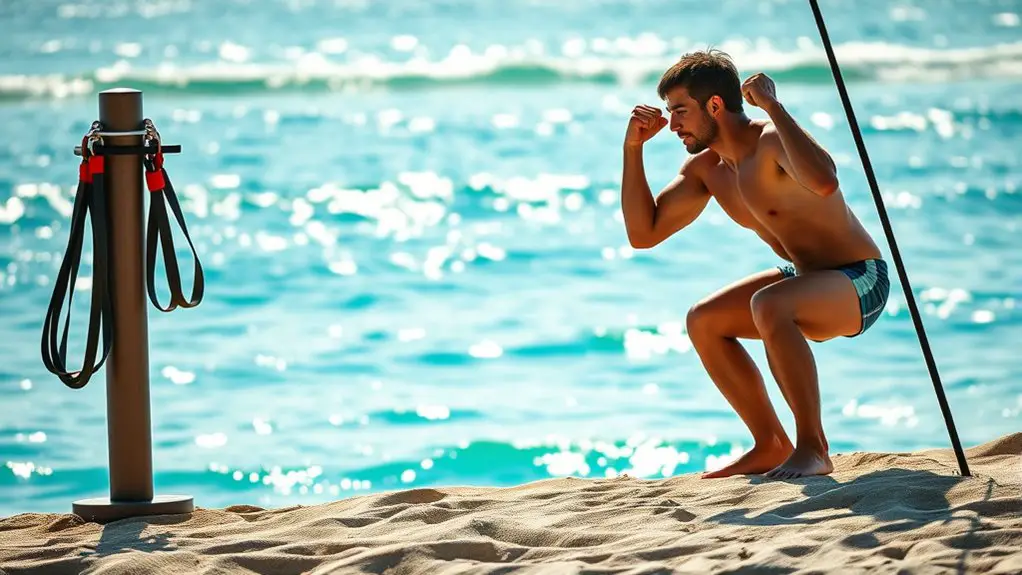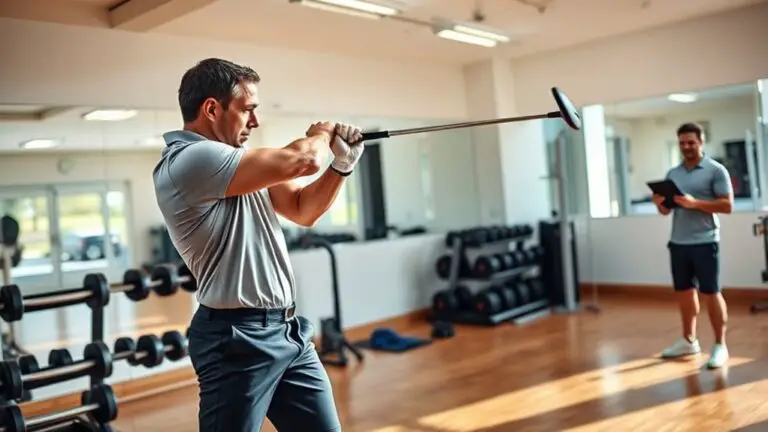The Best Strength Training Exercises for Surfing Performance

To boost your surfing performance, focus on strength training that targets your core, upper body, and legs. Core exercises like planks improve balance, while push-ups and pull-ups enhance paddling power. Don’t forget about lower body strength with squats and lunges for stability on the board. Flexibility and endurance are also vital for agile movements and longer sessions. By incorporating these exercises, you’ll enjoy more confidence in the waves. Keep exploring to discover effective routines and tips!
The Importance of Strength Training for Surfers

When you hit the waves, having the right strength can make all the difference in your performance and enjoyment. Strength training isn’t just for athletes in the gym; it’s vital for surfers like you who want to master their surf technique. Building strength in your upper body, core, and legs helps you paddle more efficiently, catch waves with confidence, and maintain balance while riding.
Moreover, strength training plays an essential role in injury prevention. A strong body can better withstand the physical demands of surfing, reducing the risk of strains and sprains. By focusing on key muscle groups, you’ll enhance your endurance and stability, allowing you to push your limits safely.
Investing time in strength training will not only improve your overall surf performance but also guarantee you enjoy every moment on the water. So, gear up and commit to building that strength—it’ll pay off when you’re conquering those waves!
Core Strength Exercises for Better Balance
Building strength is just the beginning; developing core strength is key to enhancing your balance on the board. A strong core stabilizes you during those unpredictable waves, allowing you to maintain control and ride longer. Incorporating specific core workouts into your routine will elevate your surfing performance. Here are three essential balance drills you should consider:
- Plank Variations: Engage your entire core while building endurance. Try side planks or plank jacks for added intensity.
- Bosu Ball Squats: Performing squats on an unstable surface challenges your balance and strengthens your stabilizing muscles.
- Medicine Ball Twists: This dynamic exercise not only works your core but also mimics the rotational movements you’ll encounter while surfing.
Make these core workouts part of your training regimen, and you’ll notice improved stability and confidence on your board. Remember, a strong core is your foundation for surfing success!
Upper Body Workouts to Enhance Paddling Power

To excel in surfing, you can’t overlook the importance of upper body strength, as it directly affects your paddling power and overall performance. Strong shoulders, chest, and back muscles are essential for executing effective paddling techniques. Prioritize exercises like push-ups, pull-ups, and lat pull-downs to build the strength required for powerful strokes.
Incorporating resistance bands can enhance your upper body endurance, allowing you to paddle longer without fatigue. Focus on explosive movements, such as medicine ball slams, to improve your paddling speed and agility. Don’t forget to include exercises that target your rotator cuff, which plays a vital role in shoulder stability during paddling. Additionally, bodyweight exercises can be a great way to maintain strength and flexibility while training at home.
Lower Body Strength for Improved Stability
To catch those perfect waves, you need a solid lower body foundation for enhanced stability. By incorporating core stability exercises, leg strength workouts, and balance training techniques, you’ll build the resilience necessary to stay grounded on your board. Let’s explore how these elements can transform your surfing performance.
Core Stability Exercises
While many surfers focus on upper body strength, core stability is essential for maintaining balance and control on the waves. Strong core muscles help you stay grounded, especially when maneuvering challenging surf conditions. Incorporate these core activation and stability drills into your routine to enhance your performance:
- Plank Variations: Engage your core and improve endurance by holding different plank positions.
- Russian Twists: Strengthen your obliques while improving rotational stability, vital for turning on the waves.
- Bird-Dog Exercise: This drill enhances balance and coordination, allowing you to adapt quickly on your board.
Leg Strength Workouts
Building on a strong core, developing leg strength is essential for surfers looking to enhance their stability and performance on the water. Incorporating squat variations into your routine, like front squats and split squats, targets your quads and glutes, vital for powerful paddling and quick pop-ups. Don’t underestimate lunges; their benefits extend beyond just leg strength, improving your balance and coordination as well. Try forward, reverse, and lateral lunges to engage different muscle groups and mimic the movements you’ll encounter while surfing. By consistently integrating these exercises, you’ll build a solid foundation, leading to greater stability on your board. Remember, strong legs translate to better control and confidence in the waves—so get to work and feel the difference!
Balance Training Techniques
Achieving ideal balance is essential for surfers, as it directly impacts your control and agility on the board. Incorporating balance training techniques into your routine can greatly enhance your performance. Here are three effective methods to evaluate:
- Balance Drills: Incorporate exercises like single-leg stands or lunges to improve your proprioception and coordination.
- Stability Boards: Use stability boards to challenge your core stability and engage the muscles necessary for maintaining balance while riding waves.
- Dynamic Movements: Perform agility drills that mimic surfing motions, like lateral hops or quick turns, to develop muscle memory and enhance your responsiveness on the board.
Flexibility and Mobility: Key Components of Surfing
Although many surfers focus solely on strength and endurance, flexibility and mobility are essential components that can greatly enhance your performance in the water. Improved flexibility allows for a greater range of motion, which directly impacts your surf technique. When you can twist, bend, and reach fluidly, you’ll find it easier to execute maneuvers and adapt to changing wave conditions.
Moreover, prioritizing mobility plays a vital role in injury prevention. Tight muscles and joints can lead to strains and overuse injuries, sidelining your surfing sessions. Incorporating dynamic stretches and mobility drills into your routine not only keeps your body agile but also enhances your overall control on the board.
Resistance Training Techniques for Surfers

To excel in surfing, you need to focus on resistance training techniques that boost your core strength, upper body power, and leg stability. These components are essential for maintaining balance and generating explosive movements on the waves. Let’s explore how you can incorporate these exercises into your routine for peak performance.
Core Strength Development
When it comes to surfing, having a strong core isn’t just an advantage; it’s essential for maintaining balance and power on the waves. Core workouts aren’t just about aesthetics; they provide the stability training necessary to keep you upright against the ocean’s force. Here are three powerful exercises to enhance your core strength:
- Plank Variations: Build endurance and stability while engaging multiple muscle groups.
- Russian Twists: Improve rotational strength, vital for making those sharp turns on your board.
- Medicine Ball Slams: Develop explosive power, translating directly into your paddling and pop-ups.
Integrating these exercises into your routine will empower you to ride those waves with confidence and control. Your surfing performance will reflect the dedication you put into your core strength!
Upper Body Power
Building upper body power is essential for surfers, as it directly impacts your paddling efficiency and wave-catching ability. To enhance this power, incorporate powerlifting techniques like bench presses, overhead presses, and bent-over rows into your routine. These exercises not only boost strength but also improve upper body mobility, allowing for more fluid movements on the board. Focus on explosive motions, as they mimic the rapid bursts of energy needed when catching waves. Additionally, incorporating resistance bands can help improve stability and flexibility in your shoulders and back. By prioritizing upper body power, you’ll find yourself better equipped to tackle those challenging waves and maximize your time in the water. So, get to work and release your full surfing potential!
Leg Stability Exercises
Leg stability is essential for surfers, as it directly influences balance and control on the board. When you enhance your leg stability, you’ll ride the waves with more confidence and power. Here are three effective leg stability exercises to incorporate into your routine:
- Single-leg balance drills: Stand on one leg while maintaining your focus. This builds strength and stability in your lower body.
- Stability ball squats: Position a stability ball between your lower back and a wall as you squat. This engages your core and improves balance.
- Lateral band walks: Place a resistance band around your legs and step side to side. It targets your hip muscles, vital for maintaining stability while surfing.
Incorporate these exercises, and you’ll notice a significant improvement in your performance!
Endurance Building for Longer Sessions in the Water

While you’re out on the waves, having the stamina to keep paddling and catching waves can make all the difference in your surfing experience. To build endurance, incorporating cardio workouts into your routine is essential. These exercises enhance your cardiovascular fitness, allowing you to stay active longer without fatigue.
Interval training is particularly effective; alternating between high-intensity bursts and recovery periods mimics the demands of surfing. For instance, try sprinting for 30 seconds, followed by a minute of walking, and repeat this cycle. This not only boosts your endurance but also improves your overall power and speed.
Additionally, consider longer steady-state sessions, like running or cycling, to enhance your aerobic capacity. When you develop your endurance through these workouts, you’ll find it easier to paddle out, catch those waves, and enjoy your time in the water without feeling worn out. Keep pushing your limits, and you’ll see the benefits on your next surf session!
Essential Equipment for Surf-Specific Strength Training
When it comes to surf-specific strength training, having the right equipment can make all the difference in your performance on the waves. Effective equipment selection not only enhances your training but also builds the strength you need to conquer those challenging swells. Here are three essential items you should consider:
- Resistance Bands: Perfect for improving your paddling strength and flexibility, they’re versatile and easy to use anywhere.
- Dumbbells: These are great for building overall strength and can target specific muscle groups important for balance and stability while surfing.
- Foam Roller: A critical tool for recovery, it helps release muscle tension and improves mobility, allowing you to train harder and surf longer.
With the right equipment at your disposal, you’ll maximize your surf training and elevate your performance. So gear up, stay motivated, and get ready to ride those waves like never before!
Sample Strength Training Routine for Surfers

To maximize your surfing performance, it’s vital to integrate a well-structured strength training routine. We’ll outline essential exercises tailored for surfers, provide a weekly training schedule, and share tips for tracking your progress effectively. With this approach, you’ll build the strength and endurance needed to conquer those waves.
Essential Exercises Overview
Incorporating strength training into your surfing routine is essential if you want to enhance your performance and stamina on the waves. Focusing on specific exercises can lead to incredible training adaptations that will have you carving through water with ease. Here are three vital exercises you should include:
- Squats – Build leg strength and stability for powerful paddling.
- Push-Ups – Develop upper body strength, critical for popping up quickly on your board.
- Planks – Strengthen your core, improving balance and control while riding the waves.
Weekly Training Schedule
While planning your strength training routine, it’s crucial to create a balanced weekly schedule that targets all the muscle groups essential for surfing. Aim for four to five strength training sessions each week, incorporating workout variations to keep things fresh and engaging. Start with a full-body workout on Monday, focusing on compound exercises like squats and deadlifts. Follow this with upper body strength on Wednesday and core stability on Friday. Include a lighter recovery day with mobility work on Tuesday and Thursday. Remember, recovery strategies are just as important as the workouts themselves, so don’t neglect rest days. This approach not only enhances your strength but also builds endurance and resilience, helping you ride those waves like a pro!
Performance Tracking Tips
As you commence your strength training journey for surfing, tracking your performance can be a game changer. By focusing on specific performance metrics, you can tailor your workouts to enhance your surf skills effectively. Here are three powerful tips to help you get started:
- Maintain Training Logs: Document your exercises, sets, and reps consistently to identify progress and setbacks.
- Set Clear Goals: Establish both short-term and long-term objectives to keep you motivated and focused on improvement.
- Regular Assessments: Periodically evaluate your performance metrics, like strength gains and endurance levels, to refine your training regimen.
Utilizing these strategies will not only boost your performance but also deepen your connection with the waves. Stay committed, and watch how you transform!
Tips for Staying Motivated and Consistent in Training

How can you keep your motivation high and stay consistent with your training? It starts with effective goal setting and having accountability partners. Set specific, measurable, and achievable goals to track your progress. You’re more likely to stick with your program when you know exactly what you’re working towards.
| Tip | Action | Benefit |
|---|---|---|
| Set Clear Goals | Write down your fitness objectives | Provides direction and focus |
| Find an Accountability Partner | Train with a friend or coach | Increases commitment and support |
| Track Your Progress | Use a journal or app to log workouts | Helps visualize achievements |
These strategies will help you maintain motivation and consistency. Remember, every small step contributes to your overall performance in surfing, so celebrate your wins along the way!
Frequently Asked Questions
How Often Should Surfers Incorporate Strength Training Into Their Routine?
To optimize your surfing performance enhancement, you should aim to incorporate strength training into your routine two to three times a week. This frequency allows your muscles to recover while building strength and endurance, essential for tackling those challenging waves. Focus on compound movements that engage multiple muscle groups. Consistency is key; the more regularly you train, the more you’ll notice improvements in your balance, power, and overall surfing ability.
Can Strength Training Prevent Surfing Injuries?
Think of your body as a well-tuned surfboard; strength training’s like waxing it for a smooth ride. It plays a vital role in injury prevention, giving you the strength benefits needed to withstand the physical demands of surfing. By building muscle and improving stability, you’re less likely to get hurt during those intense sessions. So, commit to strength training, and you’ll ride the waves with more confidence and fewer worries about injuries.
What Should I Eat to Support Strength Training for Surfing?
To support your strength training for surfing, focus on nutrition timing and quality protein sources. Eating a balanced meal with protein, healthy fats, and carbs before and after workouts can enhance recovery and muscle growth. Opt for lean meats, fish, eggs, or plant-based proteins like beans and quinoa. Don’t forget to hydrate! Fueling your body right will boost your performance and help prevent injuries, keeping you in the water longer.
Is It Better to Train Indoors or Outdoors for Surfing Strength?
You might wonder if training indoors or outdoors is more effective. While indoor advantages include controlled environments and access to specialized equipment, outdoor benefits like fresh air and natural terrain can enhance your mental toughness and adaptability. Mixing both can maximize your strength training, allowing you to harness the focus of indoor workouts and the dynamic challenges of outdoor sessions. Ultimately, it’s about balancing the two to elevate your performance.
How Can I Track My Strength Training Progress Effectively?
To track your strength training progress effectively, start by setting clear goals and recording your strength metrics regularly. Use a training journal or apps to log your workouts, noting weights, reps, and sets. This’ll help you visualize improvements over time. Incorporate periodic assessments, like max lifts or performance tests, to gauge progress. Consistency is key, so stay committed, and don’t forget to celebrate your achievements along the way!





